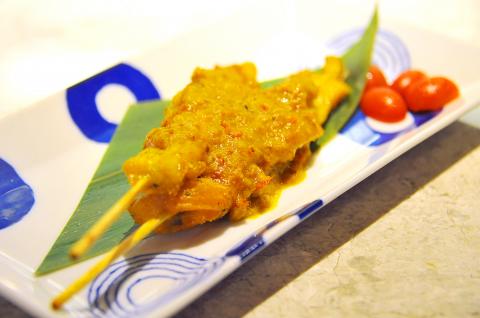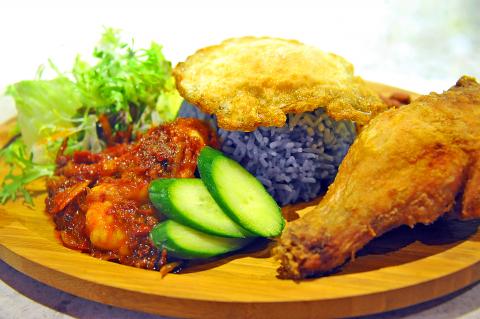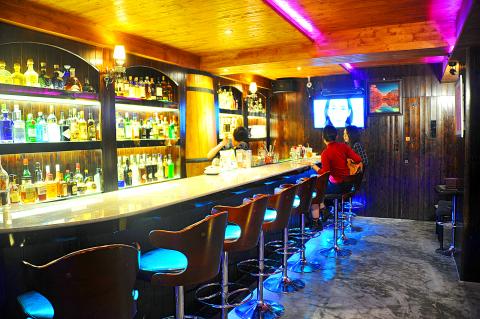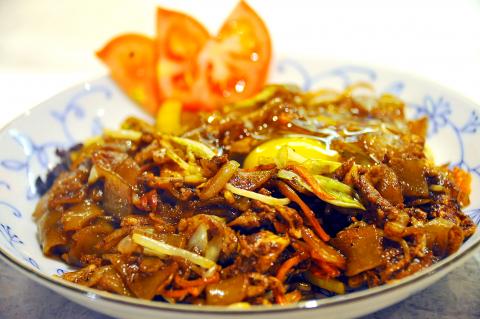Little Nyonya Bistro Bar looks so much like a typical trendy watering hole that it is hard to imagine that it serves a full menu of Malaysian cuisine.
The restaurant’s namesake refers to the term for women in Peranakan culture, descendants of Chinese immigrants who moved to Malaysia hundreds of years ago, and it’s reflected in the food which contains many Chinese elements. My Malaysian friend swears by this place, especially because the kitchen is open until midnight.
The main space consists of a large bar with just a few tables and chairs on the side for seating. Still wouldn’t guess they serve Malaysian food here, until the waiter brings the menus over.

Photo: Han Cheung, Taipei Times
We order the Malaysian staples of satay chicken (NT$130), nyonya style nasi lemak (NT$250, a fragrant rice platter that’s often considered the national dish), and stir fried kuey teow (broad rice noodles) with raw egg (NT$250). For some fiber, we ordered the stir-fried cabbage (NT$130).
Everything came at about the same time, which was great because of the contrast in the elements that made it fun to mix and match. For those who imagine Malaysian cuisine to be strong and spicy, the food here is actually quite subtle — instead of jumping out at once, the flavors grow on the tongue as the meal goes on.
The chicken satay appetizer contained two skewers. The chicken was a bit dry and chewy but the peanut-based sauce hit the right flavor notes, creamy but not too sweet and not overly slathered on the meat.

Photo: Han Cheung, Taipei Times
The two main dishes contrasted well. The rice noodles were soft and slightly sweet with hints of soy sauce, with the raw egg enhancing the soft texture without making things mushy. The additional ingredients of succulent shrimp, tender beef and crunchy vegetables round out the experience. There was a slightly smoky aroma overall.
The rice platter was very colorful in comparison and fell on the sweeter side, accompanied by a variety of goodies including peanuts with crispy dried anchovies, fresh cucumbers and a deep fried chicken leg. The most noticeable aspect of this dish is the blue rice, which is wafting with unique floral undertones — a result of the rice being cooked with the blue butterfly pea flower. In bold red hues, the sambal paste provides the sweetness. Made with chilies, shrimp paste palm sugar and other ingredients, it’s mostly straight up sugary sweet with fishy hints, and only mildly spicy.
The components can be strong when eaten on their own, and the best way is to mix everything in small doses by the spoonful. The result is an explosion of flavors and textures that makes it clear why this hearty creation is considered Malaysia’s national dish.

Photo: Han Cheung, Taipei Times
Compared to the other plates, the cabbage was very lightly seasoned but not bland, still aromatic with aftertastes of garlic and fish. It works with the overall scheme, refreshingly complementing the bolder items.
It was a very complex dinner with many subtleties that grew on me, and the food only got better as the meal went on before I suddenly realized that I was full.
Other classic Malaysian and/or Peranakan staples include Klang style bak kut teh (NT$250), a pork rib dish cooked in a spiced herbal broth, and chicken rendang (NT$210), a dry curry with coconut milk and other spices.

Photo: Han Cheung, Taipei Times
With a full bar, the place also has a large variety of cocktails and spirits, but I think I’ll be mostly coming here for the food.

The canonical shot of an East Asian city is a night skyline studded with towering apartment and office buildings, bright with neon and plastic signage, a landscape of energy and modernity. Another classic image is the same city seen from above, in which identical apartment towers march across the city, spilling out over nearby geography, like stylized soldiers colonizing new territory in a board game. Densely populated dynamic conurbations of money, technological innovation and convenience, it is hard to see the cities of East Asia as what they truly are: necropolises. Why is this? The East Asian development model, with

June 16 to June 22 The following flyer appeared on the streets of Hsinchu on June 12, 1895: “Taipei has already fallen to the Japanese barbarians, who have brought great misery to our land and people. We heard that the Japanese occupiers will tax our gardens, our houses, our bodies, and even our chickens, dogs, cows and pigs. They wear their hair wild, carve their teeth, tattoo their foreheads, wear strange clothes and speak a strange language. How can we be ruled by such people?” Posted by civilian militia leader Wu Tang-hsing (吳湯興), it was a call to arms to retake

This is a deeply unsettling period in Taiwan. Uncertainties are everywhere while everyone waits for a small army of other shoes to drop on nearly every front. During challenging times, interesting political changes can happen, yet all three major political parties are beset with scandals, strife and self-inflicted wounds. As the ruling party, the Democratic Progressive Party (DPP) is held accountable for not only the challenges to the party, but also the nation. Taiwan is geopolitically and economically under threat. Domestically, the administration is under siege by the opposition-controlled legislature and growing discontent with what opponents characterize as arrogant, autocratic

When Lisa, 20, laces into her ultra-high heels for her shift at a strip club in Ukraine’s Kharkiv, she knows that aside from dancing, she will have to comfort traumatized soldiers. Since Russia’s 2022 invasion, exhausted troops are the main clientele of the Flash Dancers club in the center of the northeastern city, just 20 kilometers from Russian forces. For some customers, it provides an “escape” from the war, said Valerya Zavatska — a 25-year-old law graduate who runs the club with her mother, an ex-dancer. But many are not there just for the show. They “want to talk about what hurts,” she